Classification of GBC AG to Advanced Blockchain AG
| Company Name: |
Advanced Blockchain AG |
| ISIN: |
DE000A0M93V6 |
| |
| Reason for the research: |
Research Report (Note) |
| Recommendation: |
Buy |
| Target price: |
3.79 EUR |
| Target price on sight of: |
31.12.2026 |
| Last rating change: |
|
| Analyst: |
Matthias Greiffenberger, Cosmin Filker |
Advanced Blockchain 2.0
Advanced Blockchain AG recently presented its new strategy paper on ABAG 2.0. The proposed strategic realignment of Advanced Blockchain AG aims to transform the previously highly opportunistic and incubation-driven business model into a predictable, capital market-ready, and multi-diversified platform model. The starting point is a self-critical analysis of the ABAG 1.0 phase, in which rapid growth, a large number of companies, and a high proportion of illiquid, partly token-based commitments had led to a level of complexity that could no longer be managed with a very small core team. In addition, from an investor's perspective, this phase was burdened by issues such as insufficient transparency, delayed or cumbersome reporting, and excessive dependence on market windows, i.e., times when tokens or investments could actually be liquidated. The new strategy addresses precisely these issues and aims to improve earnings, balance sheet quality, and governance simultaneously.
At the heart of the strategic planning is the development of a clearly structured platform architecture with five distinct but closely interlinked pillars. The first and most visible pillar is the treasury orientation. It is intended to create a balance sheet basis based on a strategic Bitcoin reserve, supplemented by a selective Ethereum component. This reserve fulfills a dual function. On the one hand, it creates an on-chain verifiable asset that can be communicated to investors in a transparent and credible manner. In addition to Bitcoin, other tokens can also be used as verifiable reserves. Second, ABAG acts as a publicly-traded proxy for institutional investors who are not allowed to invest directly in spot Bitcoin due to regulatory, tax, or custody restrictions. The company is thus addressing a market segment that has been underserved in Europe to date and positioning itself in an emerging niche in which only a few publicly-traded 'Bitcoin reserve' companies are currently active. At the same time, this structure opens up the possibility of issuing capital market-oriented instruments such as low-interest convertible bonds and reinvesting the funds raised in this way back into the reserve. The plan describes this mechanism as a flywheel effect: more Bitcoin leads to greater investor interest and a higher implied company value. The increased value improves the issuance conditions, allowing additional reserves to be built up. The treasury strategy is flanked by a regime-based control model that divides market phases into bullish, sideways, and bearish scenarios and provides defined allocation and hedging measures for each phase. This framework primarily serves to reduce risk. Beyond the simplified presentation in the strategy paper, the company is working on an expanded internal model with more refined sub-regimes and automated signal thresholds, which will undergo comprehensive backtesting prior to operational implementation. The aim is to avoid having to liquidate holdings even in periods of weakness, but rather to generate ongoing income through structured instruments such as covered calls or conservative lending approaches, thereby smoothing the volatility of treasury results.
The second pillar is the investment platform. In the future, the investment arm will focus on token-based investments, both liquid tokens and SAFT structures. Traditional equity investments will only be made in exceptional cases ('edge cases'). Among other things, DePIN and robotics-related infrastructures, the interface between artificial intelligence and blockchain, tokenized real-world assets, and interoperability and infrastructure layers are mentioned. A characteristic feature here is the preference for tokens and SAFT structures over traditional equity, as these generally allow for a faster return on capital and thus reduce portfolio risk. In the medium to long term, the plan is to launch vertical special funds. This would allow ABAG to decouple part of its value creation from its own balance sheet risk and establish management fees as a recurring source of income. For a small cap in the blockchain segment, this would be a significantly more mature income mix than before.
The third pillar concerns innovation. The company recognizes that its previous form of incubation, with high upfront costs, a large developer base, and long amortization periods, is not financially sustainable in a volatile market. Instead, access to innovation is to be established through existing accelerator programs, grants, and ecosystem partnerships. ABAG actively participates in deal sourcing for the programs by contributing its own investment opportunities while also benefiting from its partners' deal flow, creating a mutually beneficial deal sourcing structure. Access is thus maintained, while capital intensity is reduced. This element is important because it feeds the pipeline for the investment pillar without inflating the balance sheet.
The fourth pillar is consulting for wealthy private structures and family offices. The strategy assumes that acceptance of digital assets in this segment has now increased significantly, but that operational expertise, tooling, and governance are often lacking. ABAG aims to fill this gap by supporting in setting up custody structures, selecting secure yield strategies such as staking, restaking, or secured lending, and ongoing portfolio monitoring. The key point is that these services can be remunerated independently of token prices and can therefore be easily established as a recurring component in the results. At the same time, a circle of potential co-investors for future funds or direct transactions is created.
The fifth pillar is an analytics or data infrastructure that has already been designed under ABX Analytics. The analytics platform provides all business pillars with standardized due diligence processes, data on financing rounds, and project and market comparisons. It is a central cross-sectional element that supports informed decisions in all areas. In addition, the plan is to monetize this platform externally, for example in the form of subscriptions or API access.
The timeline presented for 2026 to 2028 translates the strategic architecture of ABAG 2.0 into a sequence of concrete milestones relevant to the capital market. The first steps will be to stabilize the balance sheet and organization, expand the treasury position, increase the proportion of liquid assets, and launch the advisory unit. At the same time, the PoC (proof of concept) and MVP (minimum viable product) of the analytics platform are to be completed, but with explicit reference to previously identified institutional pilot customers. The planned simplification of the group structure in the same phase is imperative because only a streamlined set of legal entities will enable standardized reporting and thus the capital market transactions planned for later on to be carried out in a technically sound manner.
In 2027, the focus of planning will shift noticeably from development and testing to scaling. The first marketable Bitcoin-related product component is planned, flanked by possible further capital market measures. At the same time, the investment and consulting pillars will no longer work on an ad hoc basis, but with active portfolio management and conversion of earlier mandates into recurring engagements. The beta version of ABX Analytics is also expected in this phase, which from a research perspective marks the transition from internal enablement to an externally marketable product. Particularly noteworthy is the placement of a first specialized investment fund. If this step is successful, ABAG would have a structured, management fee-eligible source of income for the first time that is not tied to its own balance sheet funds and increases the attractiveness of the platform to institutional investors.
The plan for 2028 is to have a fully developed and operationally-consolidated platform. The plan is to introduce a second, replicated Bitcoin product, continue to use capital-market-oriented financing instruments, build a broadly diversified portfolio across all defined verticals, and establish an institutionalized analytics unit with an international customer base. ABAG is thus establishing a bear-market-resilient business model with stable, recurring revenues spread across all five pillars. In this final stage, the plan describes ABAG as a hybrid institution between an investment house and a data-driven financial platform that can both serve the innovation cycles of the blockchain economy and translate them into the language and processes of traditional capital market participants. The stages build on each other. Each subsequent stage requires the successful implementation of the previous one. Without a simplified structure and robust reporting, no convertible instruments can be placed. Without initial paying mandates in consulting and without functioning analytics pilots, it is not possible to credibly tell the story of a recurring, non-market-cyclical business. On a positive note, the plan implicitly takes these dependencies into account and does not assume sudden jumps in revenue, but rather a sequential ramp-up based on verifiable intermediate steps.
In evaluating this strategy, it is initially positive that it addresses the weaknesses of the past very directly. The lack of recurring revenues will be replaced by consulting mandates, future fund fees, treasury monetization, and subscription fees from the ABX Analytics platform. The complex structure is to be replaced by clearly defined pillars. The balance sheet risk of own projects is mitigated by a shift toward external programs. The capital market reference is also clearer than before. A listed company that continuously verifies its digital reserves on chain, disciplines corporate development through governance and reporting, and has a recognizable, transferable model for treasury management is much easier for investors to evaluate than a mixture of many small, difficult-to-assess ventures.
From our perspective, we can conclude that the strategy is conceptually sound because it accepts the cyclical nature of crypto but seeks to cushion it operationally. It combines a narrative that is well known and accepted in the market, namely linking the share price to a growing Bitcoin reserve, with elements that typically lead to higher multiples, namely recurring consulting and platform revenues. The open questions do not lie in the concept, but in the evidence. The decisive factors will be whether the company achieves its first visible successes in the short term in terms of its schedule and whether external customers not affiliated with the group can be won over for the consulting or analytics track.
You can download the research here: 20251117_Note_ABAG_en
Contact for questions:
GBC AG
Halderstraße 27
86150 Augsburg
0821 / 241133 0
[email protected]++++++++++++++++
Offenlegung möglicher Interessenskonflikte nach § 85 WpHG und Art. 20 MAR Beim oben analysierten Unternehmen ist folgender möglicher Interessenkonflikt gegeben: (5a,11); Einen Katalog möglicher Interessenkonflikte finden Sie unter:
http://www.gbc-ag.de/de/Offenlegung
+++++++++++++++
Completion: 17.11.2025 (11:00 Uhr)
First disclosure: 18.11.2025 (12:00 Uhr)
The EQS Distribution Services include Regulatory Announcements, Financial/Corporate News and Press Releases.
View original content: EQS News









 Suche
Suche


 Teilen
Teilen
 Link kopieren
Link kopieren
 boerse.de-Newsletter
boerse.de-Newsletter










